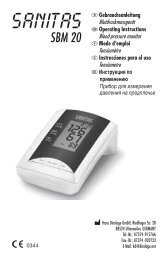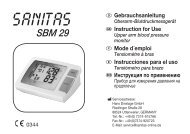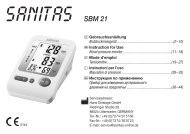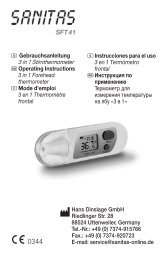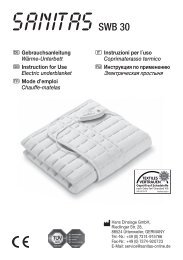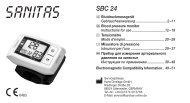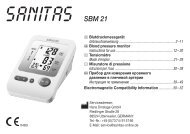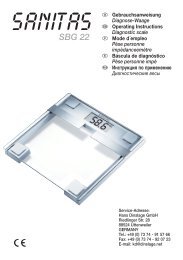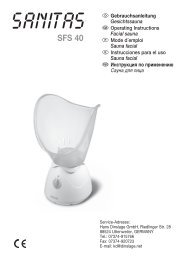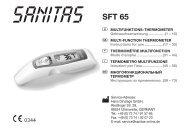SBG 39 - Sanitas
SBG 39 - Sanitas
SBG 39 - Sanitas
Create successful ePaper yourself
Turn your PDF publications into a flip-book with our unique Google optimized e-Paper software.
Man<br />
Woman<br />
top good average poor<br />
top good average poor<br />
Age very good good average poor<br />
Age very good good average poor<br />
10 -14 21,1 % 10-14 26,1 %<br />
15 -19 22,1 % 15-19 27,1 %<br />
20 - 29 23,1 % 20-29 28,1 %<br />
30 - <strong>39</strong> 24,1 % 30-<strong>39</strong> 29,1 %<br />
40 - 49 25,1 % 40-49 30,1 %<br />
50 - 59 26,1 % 50-59 31,1 %<br />
60 - 69 27,1 % 60-69 32,1 %<br />
70 -100 28,1 % 70-100 33,1 %<br />
A lower value is often found in athletes. Depending on the type of sports, training intensity and physical<br />
constitution, values may result which are below the recommended values stated.<br />
It should, however, be noted that there could be a danger to health in the case of extremely low values.<br />
Body water<br />
The body water percentage is normally within the following ranges:<br />
Man<br />
Woman<br />
Age poor good very good<br />
Age poor good very good<br />
10 -100 65<br />
10-100 60<br />
Body fat contains relatively little water. Therefore persons with a high body fat percentage have<br />
body water percentages below the recommended values. With endurance athletes, however, the recommended<br />
values could be exceeded due to low fat percentages and high muscle percentage.<br />
Body water measurement with this scale is not suitable for drawing medical conclusions, for example<br />
concerning age-related water retention. If necessary ask your physician.<br />
Basically, a high body water percentage should be the aim.<br />
Muscle percentage<br />
The muscle percentage is normally within the following ranges:<br />
Man<br />
Woman<br />
Age low normal high<br />
10 -14 57 %<br />
15 -19 56 %<br />
20 - 29 54 %<br />
30 - <strong>39</strong> 52 %<br />
40 - 49 50 %<br />
50 - 59 48 %<br />
60 - 69 47 %<br />
70 -100 46 %<br />
Age low normal high<br />
10-14 43 %<br />
15-19 41 %<br />
20-29 <strong>39</strong> %<br />
30-<strong>39</strong> 38 %<br />
40-49 36 %<br />
50-59 34 %<br />
60-69 33 %<br />
70-100 32 %<br />
Bone mass<br />
Like the rest of our body, our bones are subject to the natural development, degeneration and ageing<br />
processes. Bone mass increases rapidly in childhood and reaches its maximum between 30<br />
and 40 years of age. Bone mass reduces slightly with increasing age. You can reduce this degeneration<br />
somewhat with healthy nutrition (particularly calcium and vitamin D) and regular exercise. With<br />
appropriate muscle building, you can also strengthen your bone structure.<br />
Note that this scale will not show you the calcium content of your bones, but will measure the<br />
weight of all bone constituents (organic substances, inorganic substances and water).<br />
13



